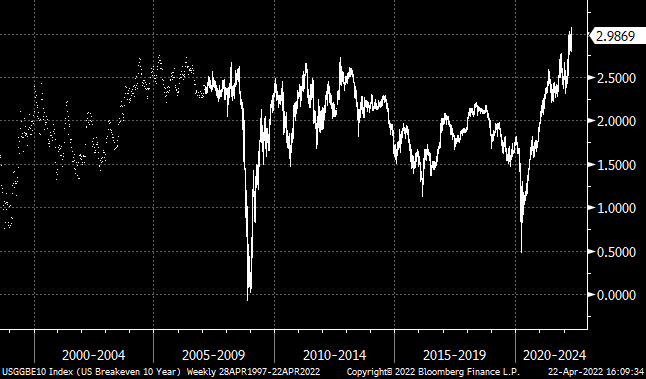This article was written exclusively for Investing.com
- Fed-speak last week was designed to test market reaction to trial balloon of 75bps
- Markets clearly rejected the Fed’s inquiry in this regard
- Hawk talk is easy and consequence-free. Actions will be more measured.
Way back in the misty recesses of bond market history—that would be the early 1990s—monetary policy was still conducted largely in the shadows. When the Federal Reserve met on policy, there was no post-meeting announcement or heaven forbid a press conference about what they had decided. The change in policy was communicated by call-and-response.
Suppose the overnight Fed funds rate had been at 5% and market expectations were for a rate hike. The interbank brokers would set the market at 5.25% and wait to see how the Fed’s Open Markets Desk would respond during their scheduled intervention time of 11:30am. If the Desk came in with "system repos,” it signaled that they thought the 5.25% rate was too high—therefore, they were telling the market that no tightening had actually been implemented. If they came in with “matched sales,” it meant 5.25% was too low and the Fed had raised rates to at least 5.50%. (The message being: we’ll have to wait until tomorrow, when we repeat the experiment again, until we know whether it’s 5.50% or 5.75%.) If there was no action from the Desk, it meant they were comfortable with 5.25%.
Nowadays, the call and response is reversed: the Fed calls, the market responds.
Coming into this week, the market assumed that the FOMC is planning to hike overnight rates by 50bps at its May 4 meeting, and that was priced in. Then, last Monday, St. Louis Fed President Bullard casually mentioned that he “wouldn’t rule out” a 75bps hike in interest rates at some point.
On Tuesday, 5-year interest rates shot up 13bps to 2.92%. Remember, as recently as September the 5-year Treasury note was at 0.75%! After a small retracement on Wednesday, yields exceeded 3% on Thursday and got to almost 3.05% on Friday. Now, Bullard is understood to be a hawk. But on Thursday Fed Chairman Powell delivered his most-hawkish comments yet although he didn’t specifically mention 75bps.
Stocks that morning were in the process of setting a two-week high, but heard the message. Between early Thursday and Friday’s close, the S&P dropped 5.4% on increasing volume (see chart, source Bloomberg). The clear message? “We were okay with 50bps. But back off a bit from the 75bps talk.”
The FOMC found the pain point. The hawkish talk was their call, and the market response is crystal clear. As a result, we can be pretty sure the Fed will not be hiking 75bps on May 4 and, if the stock market doesn’t find a floor in the next few days, you can be confident that Fed speakers will come forth with soothing utterances.

Taking a Step Back…
But it is still all talk. Yes, it is now consensus opinion that the monetary response to COVID was wrong; the Fed went too far and inflation now needs to be addressed. Hoisington—a shop legendary for the view that the risk was for long-term deflation, and not inflation—is even on board and had an interesting point in a letter this week: the low unemployment rate helped a few tens of millions of people, but high inflation has hurt 170 million. Inflation must be addressed. But…what if the stock market drops 10% and hundreds of millions of people lose money?
Talk is a free option. In the same way that I can talk up my rugby prowess around the water cooler, there is really no downside to the talk until it comes time to hit the pitch. Then, talk is cheap (which is nice, since nothing else is still cheap). The truth of the matter lies not in the talk but in whether I am able to stand back up after the first time a 250-pound prop de-cleats me.

Image: Barnaby Conrad via Britannica
Spanish bullfighter Domingo Ortega said it best about the difference between the talkers and the doers:
“Bullfight critics ranked in rows/crowd the enormous Plaza full/But there is only one who knows, and he is the one who fights the bull.”
And how appropriate is that reference, after all? The Fed is gradually killing the bull, and trying to avoid getting gored in the process. Ortega also said that when the matador was injured it was never the bull’s fault. The Chairman of the Federal Reserve knows that if the stock market takes a dive, it is going to be perceived as his fault.
The problem is that these things cannot coexist. Inflation will not be tamed by gradual hikes that take overnight rates to only 2.5%. High inflation, if not addressed, destroys real returns in every financial asset class. High interest rates, especially in concert with high energy prices, will provoke recession. And high stock multiples cannot survive high discount rates, potential recession, and rapid changes in the outlook for both.
This past week, the markets started to see the incongruity and are beginning to resolve the fact that the forward interest rate curve is not consistent with the forward inflation curve and the forward equity curve.

Ten-year inflation breakevens reached new all-time highs (since TIPS were issued in 1997) this past week—see the chart above. If you believe the stock market, then you should buy bonds. If you believe the bond market, then you should sell stocks.
The Fed doesn’t meet this week; that’s next week. But some of the data this week will be grist for those discussions. I should reiterate that I think the Fed has been ‘greenlighted’ by the market to hike rates by 50bps, and barring some significant developments this week that is the likely outcome.
The discussion is about how quickly the Committee would like to get rates to what it considers “neutral” although almost no one else does. Tuesday’s S&P Corelogic Case-Shiller housing data (20-city expected +1.5% m/m, 19.20% y/y) is an important number although it is slow-moving and so unlikely to affect the Fed’s decision in the short run.
On Thursday, the Advance GDP report for Q1 will trigger many searches of the word “stagflationary” with expected growth to be only 1.0% annualized but with +5.6% core PCE. The numbers will be consistent with an increase in money velocity, although since we don’t have March’s M2 figures yet we won’t be sure of this. On Friday we get the only ‘new’ inflation information, with the Employment Cost Index expected to be +1.1% q/q—another new 1.5-generation high in the y/y number.
Aside from the data, we will be especially attentive to news from China. It is hard to imagine that the country can remain in lockdown—let alone expand it—for very long when the rest of the world is shedding masks, but the longer they do the less likely aggressive Fed action over the next six months becomes. I continue to think that the short end of the Treasury curve has discounted too-aggressive Fed action, the long end has not discounted enough of the actual shift in the inflation equilibrium, and the stock market still discounts an implausibly rosy outcome.
Michael Ashton, sometimes known as The Inflation Guy, is the Managing Principal of Enduring Investments, LLC. He's a pioneer in inflation markets with a specialty in defending wealth against the assaults of economic inflation, which he discusses on his Cents and Sensibility podcast.
